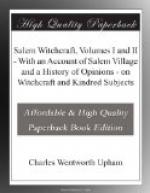[Illustration: THE PHILIP ENGLISH HOUSE.—VOL. II., 142.]
[Illustration: Witch Hill. 1866.]
PART THIRD.
WITCHCRAFT AT SALEM VILLAGE.
We left Mr. Parris in the early part of November, 1691, at the crisis of his controversy with the inhabitants of Salem Village, under circumstances which seemed to indicate that its termination was near at hand. The opposition to him had assumed a form which made it quite probable that it would succeed in dislodging him from his position. But the end was not yet. Events were ripening that were to give him a new and fearful strength, and open a scene in which he was to act a part destined to attract the notice of the world, and become a permanent portion of human history. The doctrines of demonology had produced their full effect upon the minds of men, and every thing was ready for a final display of their power. The story of the Goodwin children, as told by Cotton Mather, was known and read in all the dwellings of the land, and filled the imaginations of a credulous age. Deputy-governor Danforth had begun the work of arrests; and persons charged with witchcraft, belonging to neighboring towns, were already in prison.
Mr. Parris appears to have had in his family several slaves, probably brought by him from the West Indies. One of them, whom he calls, in his church-record book, “my negro lad,” had died, a year or two before, at the age of nineteen. Two of them were man and wife. The former was always known by the name of “John Indian;” the latter was called “Tituba.” These two persons may have originated the “Salem witchcraft.” They are spoken of as having come from New Spain, as it was then called,—that is, the Spanish West Indies, and the adjacent mainlands of Central and South America,—and, in all probability, contributed, from the wild and strange superstitions prevalent among their native tribes, materials which, added to the commonly received notions on such subjects, heightened the infatuation of the times, and inflamed still more the imaginations of the credulous. Persons conversant with the Indians of Mexico, and on both sides of the Isthmus, discern many similarities in their systems of demonology with ideas and practices developed here.
Mr. Parris’s former residence in the neighborhood of the Spanish Main, and the prominent part taken by his Indian slaves in originating the proceedings at the village, may account for some of the features of the transaction.
During the winter of 1691 and 1692, a circle of young girls had been formed, who were in the habit of meeting at Mr. Parris’s house for the purpose of practising palmistry, and other arts of fortune-telling, and of becoming experts in the wonders of necromancy, magic, and spiritualism. It consisted, besides the Indian servants, mainly of the following persons:—




